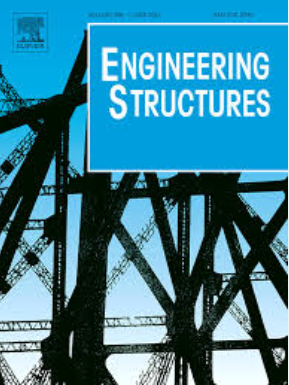钢-聚合物砂浆加固砌体结构震害后的振动台试验
IF 6.4
1区 工程技术
Q1 ENGINEERING, CIVIL
引用次数: 0
摘要
砌体结构以其材料易得、施工方便、保温耐用等固有优点被广泛应用于住宅建筑中。近年来的地震表明,砌体结构由于其相对脆性的抗震机制而受到严重破坏。因此,砌体结构在地震破坏后的性能改善和重建受到了广泛的关注。本文提出了适用于地震破坏后砌体结构的钢与聚合物砂浆组合加固方法。通过振动台试验,对两层半比例尺加筋砌体结构(RMS)和相应的钢筋砂浆加固试验结构(R-RMS)的抗震性能进行了评价。对比分析了两种结构的动力特性、加速度响应、层间漂移响应及产生的应变。结果表明,所提出的加固方法能有效提高砌体结构震害后的承载力和抗震性能,限制塑性损伤的发展。此外,地震破坏后砌体结构的侧移刚度显著提高,R-RMS模型在x和y方向的固有频率分别提高了257.35 %和177.78 %。R-RMS模型在2层X、y方向的加速度放大系数(AAF)分别提高了69.67 %和62.21 %。在罕见烈度下,R-RMS模型在1层X方向和Y方向的层间位移分别增大76.61 %和87.30 %,而1层的层间位移远小于2层。R-RMS模型1层的最终损伤明显轻于RMS模型和R-RMS模型2层。本研究为应用所提出的钢-聚合物砂浆加固传统砌体结构提供了参考结果。本文章由计算机程序翻译,如有差异,请以英文原文为准。
Shaking table tests on masonry structures retrofitted with steel-polymer mortar after earthquake damage
Masonry structures are widely used as residential buildings due to their intrinsic advantages, such as easily available materials, convenient construction, and durable thermal insulation. Recent earthquakes have shown that the masonry structures were severely damaged due to a relatively brittle seismic resistance mechanism. Therefore, the performance improvement and reconstruction of masonry structures after earthquake damage have gained significant attention. The steel and polymer mortar combination retrofitting method suitable for masonry structures after earthquake damage has been proposed in this study. Shaking table tests were carried out to assess the seismic performance of a half-scale two-story reinforced masonry structure (RMS) and a corresponding retrofitted test structure (R-RMS) strengthened by steel and polymer mortar. The dynamic characteristics, acceleration response, story drift response, and resulting strain were compared and analyzed. The results showed that the proposed retrofitting method could effectively improve the bearing capacity and seismic performance of masonry structures after earthquake damage and limit the development of plastic damage. In addition, the lateral stiffness of the masonry structure after earthquake damage was significantly improved, and the natural frequencies of the R-RMS model in the X-and Y-directions were increased by 257.35 % and 177.78 %, respectively. The acceleration amplification factor (AAF) of the R-RMS model in the X- and Y-direction of the 2nd story was increased by 69.67 % and 62.21 %, respectively. The story drift of the R-RMS model in the X- and Y- direction of the 1st story was increased by 76.61 %, 87.30 %, respectively, while the story drift of the 1st story was much smaller than that of the 2nd story under the rare earthquake intensity. The final damage of the 1st story of the R-RMS model was significantly lighter than that of the RMS model and the 2nd story of the R-RMS model. This study provides reference results for applying the proposed steel-polymer mortar to strengthen conventional masonry structures.
求助全文
通过发布文献求助,成功后即可免费获取论文全文。
去求助
来源期刊

Engineering Structures
工程技术-工程:土木
CiteScore
10.20
自引率
14.50%
发文量
1385
审稿时长
67 days
期刊介绍:
Engineering Structures provides a forum for a broad blend of scientific and technical papers to reflect the evolving needs of the structural engineering and structural mechanics communities. Particularly welcome are contributions dealing with applications of structural engineering and mechanics principles in all areas of technology. The journal aspires to a broad and integrated coverage of the effects of dynamic loadings and of the modelling techniques whereby the structural response to these loadings may be computed.
The scope of Engineering Structures encompasses, but is not restricted to, the following areas: infrastructure engineering; earthquake engineering; structure-fluid-soil interaction; wind engineering; fire engineering; blast engineering; structural reliability/stability; life assessment/integrity; structural health monitoring; multi-hazard engineering; structural dynamics; optimization; expert systems; experimental modelling; performance-based design; multiscale analysis; value engineering.
Topics of interest include: tall buildings; innovative structures; environmentally responsive structures; bridges; stadiums; commercial and public buildings; transmission towers; television and telecommunication masts; foldable structures; cooling towers; plates and shells; suspension structures; protective structures; smart structures; nuclear reactors; dams; pressure vessels; pipelines; tunnels.
Engineering Structures also publishes review articles, short communications and discussions, book reviews, and a diary on international events related to any aspect of structural engineering.
 求助内容:
求助内容: 应助结果提醒方式:
应助结果提醒方式:


